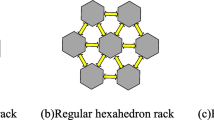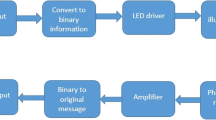Abstract
The visible light communication (VLC) has the potential to provide dense and fast connectivity at low cost. In this paper, we propose a novel VLC enabled Wireless Small-World Data Center (WSWDC). It employs VLC links to achieve a fully wireless data center network (DCN) across racks for the first time. The using of VLC links eliminates hierarchical switches and inter-rack cables, and thus reducing hardware investment, as well as maintenance cost. More precisely, to simplify the configuration and control operations, we propose three DCN design rationales: (1) fully-wireless, all inter-rack links are wireless; (2) easy-deployable, it is not necessary to change the existing infrastructure inside data center; (3) plug-and-play, no extra centralized control operations are required. Previous proposals, however, cannot achieve the three rationales simultaneously. To this end, we first use regular VLC links to interconnect racks as a regular grid DCN and optimize the rack placement to shorten the average path length and the network diameter. To further exploiting the benefits of VLC links, a few random VLC links are carefully introduced to update the wireless grid DCN as a wireless small-world DCN. To avoid the potential interference among VLC links, we deploy VLC transceivers at different heights on the top of each rack. In this way, VLC links would not interfere with others at each height level. Moreover, we design a greedy but efficient routing method for any pair of racks using their identifiers as inputs. Comprehensive evaluation results indicate that our WSWDC exhibits good topological properties and network performance.
Similar content being viewed by others
Explore related subjects
Discover the latest articles and news from researchers in related subjects, suggested using machine learning.References
Luo L, Guo D, Li W, Zhang T, Xie J, Zhou X. Compound graph based hybrid data center topologies. Frontiers of Computer Science, 2015, 9(6): 860–874
Guo D, Xie J, Zhou X, Zhu X, Wei W, Luo X. Exploiting efficient and scalable shuffle transfers in future data center networks. IEEE Transactions on Parallel and Distributed Systems, 2015, 26(4): 997–1009
Zhang J, Chen J, Luo J, Song A. Efficient location-aware data placement for data-intensive applications in geo-distributed scientific data centers. Tsinghua Science and Technology, 2016, 21(5): 471–481
Al-Fares M, Loukissas A, Vahdat A. A scalable, commodity data center network architecture. ACM Sigcomm Computer Communication Review, 2008, 28(4): 63–74
Greenberg A, Hamilton J R, Jain N, Kandula S, Kim C, Lahiri P, Maltz D A, Patel P, Sengupta S. VL2: a scalable and flexible data center network. ACM Sigcomm Computer Communication Review, 2011, 39(4): 51–62
Mysore R N, Pamboris A, Farrington N, Huang N, Miri P, Radhakrishnan S, Subramanya V, Vahdat A. PortLand: a scalable fault-tolerant layer 2 data center network fabric. ACM Sigcomm Computer Communication Review, 2009, 39(4): 39–50
Zhao Y, Wu J, Liu C. On peer-assisted data dissemination in data center networks: analysis and implementation. Tsinghua Science and Technology, 2014, 19(1): 51–64
Cui Y, Wang H, Cheng X, Chen B. Wireless data center networking. IEEEWireless Communications, 2011, 18(6): 46–53
Zhou X, Zhang Z, Zhu Y, Li Y, Kumar S, Vahdat A, Zhao B Y, Zheng H. Mirror mirror on the ceiling: flexible wireless links for data centers. ACM Sigcomm Computer Communication Review, 2012, 42(4): 443–454
Hamedazimi N, Qazi Z, Gupta H, Sekar V, Das S R, Longtin J P, Shah H, Tanwer A. Firefly: a reconfigurable wireless data center fabric using free-space optics. ACM Sigcomm Computer Communication Review, 2014, 44(4): 319–330
Ghobadi M, Mahajan R, Phanishayee A, Devanur N, Kulkarni J, Ranade G, Blanche P A, Rastegarfar H, Glick M, Kilper D. Projector: agile reconfigurable data center interconnect. In: Proceedings of ACM Sigcomm Conference. 2016, 216–229
Hussein A T, Elmirghani J M. Mobile multi-gigabit visible light communication system in realistic indoor environment. Journal of Lightwave Technology, 2015, 33(15): 3293–3307
Vijay S, Geetha K. A survey on visible light communication appliances used in inter-vehicular and indoor communication. International Journal of Applied Engineering Research, 2016, 11(7): 4893–4897
Katayama Y, Takano K, Kohda Y, Ohba N, Nakano D. Wireless data center networking with steered-beam mmwave links. In: Proceedings of Wireless Communications and Networking Conference. 2011, 2179–2184
Zhang W, Zhou X, Yang L, Zhang Z, Zhao B Y, Zheng H. 3D beamforming for wireless data centers. In: Proceedings of ACM Workshop on Hot Topics in Networks. 2011, 4
Camara J M, Moreto M, Vallejo E, Beivide R, Miguel-Alonso J, Martinez C, Navaridas J. Twisted torus topologies for enhanced interconnection networks. IEEE Transactions on Parallel and Distributed Systems, 2010, 21(12): 1765–1778
Kleinberg J. The small-world phenomenon: an algorithmic perspective. In: Proceedings of ACM Symposium on Theory of Computing. 2000, 163–170
Ranachandran K, Kokku R, Mahindra R, Rangarajan S. 60GHz datacenter networking: wireless=> worryless. NEC Technical Report, 2008
Halperin D, Kandula S, Padhye J, Bahl P, Wetherall D. Augmenting data center networks with multi-gigabit wireless links. In: Proceedings of ACM Sigcomm Conference. 2011, 38–49
Cui Y, Xiao S, Wang X, Yang Z, Zhu C, Li X, Yang L, Ge N. Diamond: nesting the data center network with wireless rings in 3D space. In: Proceedings of Usenix Conference on Networked Systems Design and Implementation. 2016, 657–669
Shin J Y, Sirer E G, Weatherspoon H, Kirovski D. On the feasibility of completely wirelesss datacenters. IEEE/ACM Transactions on Networking, 2013, 21(5): 1666–1679
Luo L, Guo D, Wu J, Rajbhandari S, Chen T, Luo X. Vlccube: a vlc enabled hybrid network structure for data centers. IEEE Transactions on Parallel and Distributed Systems, 2017, 28(7): 2088–2102
Louvros A P, Fuschelberger D. Vlc technology for indoor lte planning. In: Proceedings of System-Level Design Methodologies for Telecommunication. 2014, 21–41
Sagotra R, Aggarwal R. Visible light communication. International Journal of Computer Trends and Technology, 2013, 4(4): 906–910
Kleinfeld J S. The small world problem. Society, 2002, 39(2): 61–66
Guo D, Li C, Wu J, Zhou X. Dcube: a family of network structures for containerized data centers using dual-port servers. Computer Communications, 2014, 53: 13–25
Mittal R, Dukkipati N, Blem E, Wassel H, Ghobadi M, Vahdat A, Wang Y, Wetherall D, Zats D. TIMELY: RTT-based congestion control for the datacenter. ACM Sigcomm Computer Communication Review, 2015, 45(4): 537–550
Shin J Y, Wong B, Sirer E G. Small-world datacenters. In: Proceedings of ACM Symposium on Cloud Computing. 2011, 1–13
Ji S, Li B. Wide area analytics for geographically distributed datacenters. Tsinghua Science and Technology, 2016, 21(2): 125–135
Guo D, Wu J, Liu Y, Jin H, Chen H, Chen T. Quasi-kautz digraphs for peer-to-peer networks. IEEE Transactions on Parallel and Distributed Systems, 2011, 22(6): 1042–1055
Acknowledgements
This work is partially supported by the National Natural Science Foundation for Outstanding Excellent young scholars of China (61422214), the National Natural Science Foundation of China (Grant No. 61772544), National Basic Research Program (973 program) (2014CB347800), the Hunan Provincial Natural Science Fund for Distinguished Young Scholars (2016JJ1002), and the Guangxi Cooperative Innovation Center of cloud computing and Big Data (YD16507 and YD17X11).
Author information
Authors and Affiliations
Corresponding author
Additional information
Yudong Qin received the BS degree in management science and engineering from National University of Defense Technology, China in 2016. He is currently working towards the MS degree in College of Systems Engineering, National University of Defense Technology, China. His research interests include data centers and software-defined networks.
Deke Guo received the BS degree in industry engineering from the Beijing University of Aeronautics and Astronautics, China in 2001, and the PhD degree in management science and engineering from the National University of Defense Technology, China in 2008. He is currently a Professor with the College of Systems Engineering, National University of Defense Technology. His research interests include distributed systems, software-defined networking, data center networking, wireless and mobile systems, and interconnection networks. He is a member of the ACM.
Lailong Luo received the BS and MS degrees from the School of Information System and Management, National University of Defense Technology, China in 2013 and 2015, respectively, where he is currently pursuing the PhD degree with the College of Systems Engineering. His current research interests include data centers and software defined networks.
Geyao Cheng received the BS degree in management science and engineering from National University of Defense Technology, China in 2017. She is currently working towards the MS degree in College of Systems Engineering, National University of Defense Technology, China. Her research interests include data centers and software-defined networks.
Zeliu Ding received the MS and PhD degrees from the National University of Defense Technology, China in 2007 and 2012, respectively. He is currently a lecturer with the School of Electronic Engineering, Navy University of Engineering, China. His research interests include complex information system, cloud computing and data center networks.
Electronic supplementary material
Rights and permissions
About this article
Cite this article
Qin, Y., Guo, D., Luo, L. et al. Design and optimization of VLC based small-world data centers. Front. Comput. Sci. 13, 1034–1047 (2019). https://doi.org/10.1007/s11704-018-7315-6
Received:
Accepted:
Published:
Issue Date:
DOI: https://doi.org/10.1007/s11704-018-7315-6




